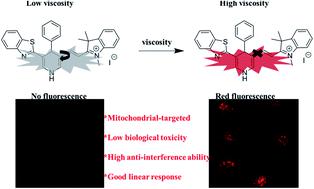当前位置:
X-MOL 学术
›
Anal. Methods
›
论文详情
Our official English website, www.x-mol.net, welcomes your
feedback! (Note: you will need to create a separate account there.)
A novel mitochondrial-targeting fluorescent probe based on 1,4-dihydropyridine to visualize and monitor the viscosity of live cells and mice in vivo
Analytical Methods ( IF 2.7 ) Pub Date : 2021-09-01 , DOI: 10.1039/d1ay01206a Longqi Xue 1 , Jialin Lv 2 , Ronghang Li 3 , Xinyu Wang 4 , Yapeng Li 1 , Jianshi Du 4 , Shaolong Qi 4 , Qingbiao Yang 1, 4 , Yaming Shan 2 , Yaoxian Li 1
Analytical Methods ( IF 2.7 ) Pub Date : 2021-09-01 , DOI: 10.1039/d1ay01206a Longqi Xue 1 , Jialin Lv 2 , Ronghang Li 3 , Xinyu Wang 4 , Yapeng Li 1 , Jianshi Du 4 , Shaolong Qi 4 , Qingbiao Yang 1, 4 , Yaming Shan 2 , Yaoxian Li 1
Affiliation

|
Cell viscosity is related to some diseases, such as diabetes, atherosclerosis, and Alzheimer's disease. These diseases can cause abnormal viscosity of the cell mitochondrial matrix. 1,4-Dihydropyridine (DHP) is an important organic compound with biological activity and is widely used in drug research. However, there are few studies on its optical properties, especially in the design of viscous fluorescent probes. In this study, a fluorescent probe for viscosity detection using 1,4-dihydropyridine as the fluorophore and indole iodide salt as the recognition group was designed and synthesized. The probe has the advantages of a deep-red emission, low cytotoxicity, good biocompatibility and excellent anti-interference ability. In addition, the probe also has the ability to target mitochondria and has been successfully applied to the detection of the viscosity response of HeLa cells and living mice, and has good clinical application potential.
中文翻译:

一种基于 1,4-二氢吡啶的新型线粒体靶向荧光探针,可在体内观察和监测活细胞和小鼠的粘度
细胞粘度与一些疾病有关,如糖尿病、动脉粥样硬化和阿尔茨海默病。这些疾病会导致细胞线粒体基质异常粘稠。1,4-二氢吡啶(DHP)是一种重要的具有生物活性的有机化合物,广泛用于药物研究。然而,对其光学特性的研究很少,特别是在粘性荧光探针的设计方面。本研究设计合成了一种以1,4-二氢吡啶为荧光团、吲哚碘盐为识别基团的粘度检测荧光探针。该探针具有深红色发射、细胞毒性低、生物相容性好、抗干扰能力强等优点。此外,
更新日期:2021-09-01
中文翻译:

一种基于 1,4-二氢吡啶的新型线粒体靶向荧光探针,可在体内观察和监测活细胞和小鼠的粘度
细胞粘度与一些疾病有关,如糖尿病、动脉粥样硬化和阿尔茨海默病。这些疾病会导致细胞线粒体基质异常粘稠。1,4-二氢吡啶(DHP)是一种重要的具有生物活性的有机化合物,广泛用于药物研究。然而,对其光学特性的研究很少,特别是在粘性荧光探针的设计方面。本研究设计合成了一种以1,4-二氢吡啶为荧光团、吲哚碘盐为识别基团的粘度检测荧光探针。该探针具有深红色发射、细胞毒性低、生物相容性好、抗干扰能力强等优点。此外,











































 京公网安备 11010802027423号
京公网安备 11010802027423号